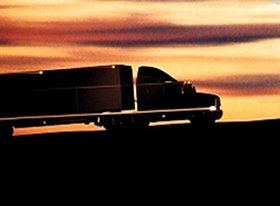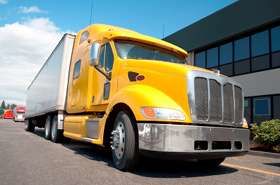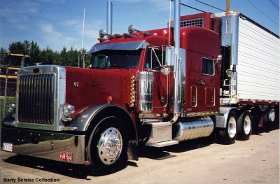Floating Gears Vs Double Clutching
Topic 10190 | Page 1
It's interesting to hear the reasons people think they should be double clutching. Double clutching does nothing to help you get it into gear. It doesn't prevent gear grinding nor does it prevent it from popping out of gear.
We've had this discussion in the past and I'm always surprised at how many people double clutch at least part of the time.
The last time I double clutched was the road exam for my CDL. There are times I had to push in the clutch to get it out of gear due to circumstances. For instance when you're going down a mountain with the revs already at the governor you can't kick the throttle to get the tension off the gears so you have to push in the clutch.
If you're brand new to shifting rigs this might confuse you more than help you. Depends upon how far along you are.
Getting it out of gear:
Pushing in the clutch will reduce the pressure on the gears allowing it to come out of gear easily. But if you use other methods to get pressure off the gears, like blipping the throttle or letting off the throttle quickly, then pushing in the clutch is not necessary.
Putting it into gear:
If you push in the clutch to get it out of gear you have to let the clutch back out in neutral to synchronize the transmission shaft speed to your engine speed because there are no synchronizers in a big rig transmission. Pushing the clutch in before putting it into gear may make for a more forgiving shift if your timing is off a little bit but has no advantage if your timing is right.
When done properly floating gears works perfectly. There is no advantage to double clutching.
CDL:
Commercial Driver's License (CDL)
A CDL is required to drive any of the following vehicles:
- Any combination of vehicles with a gross combined weight rating (GCWR) of 26,001 or more pounds, providing the gross vehicle weight rating (GVWR) of the vehicle being towed is in excess of 10,000 pounds.
- Any single vehicle with a GVWR of 26,001 or more pounds, or any such vehicle towing another not in excess of 10,000 pounds.
- Any vehicle, regardless of size, designed to transport 16 or more persons, including the driver.
- Any vehicle required by federal regulations to be placarded while transporting hazardous materials.
Floating Gears:
An expression used to describe someone who is shifting gears without using the clutch at all. Drivers are taught to "Double Clutch" or press and release the clutch twice for each gear shift. If you're floating gears it means you're simply shifting without using the clutch at all.
Double Clutch:
To engage and then disengage the clutch twice for every gear change.
When double clutching you will push in the clutch, take the gearshift out of gear, release the clutch, press the clutch in again, shift the gearshift into the next gear, then release the clutch.
This is done on standard transmissions which do not have synchronizers in them, like those found in almost all Class A trucks.
Double Clutching:
To engage and then disengage the clutch twice for every gear change.
When double clutching you will push in the clutch, take the gearshift out of gear, release the clutch, press the clutch in again, shift the gearshift into the next gear, then release the clutch.
This is done on standard transmissions which do not have synchronizers in them, like those found in almost all Class A trucks.
OWI:
Operating While Intoxicated

 Thank you Gentlemen. I feel a quite a bit better about my driving style. Bret, It was kind of funny to learn you haven't double clutched since test day, as I haven't either. On another personal yet some what comical side note , I originally attained my CDL to satisfy a pre requisite requirement to join an electrical line-man apprenticeship program. I was offered a Local gig straight out of school and have been bitten by this fever. This has been the most mentally tiring , sink or swim , personal battle I've ever had to endure aside from being a single dad to my little boys, BUT I love this. On my days off all I think about is being in the rig. My personal vehicle is an Automatic and there are times I roll up to a stop and my left foot goes fishing for a third pedal that's not there. Anyone ever sitting at a stop feel like perhaps there rolling back when there not? It's complete madness at times but its something I can't get enough of...
Thank you Gentlemen. I feel a quite a bit better about my driving style. Bret, It was kind of funny to learn you haven't double clutched since test day, as I haven't either. On another personal yet some what comical side note , I originally attained my CDL to satisfy a pre requisite requirement to join an electrical line-man apprenticeship program. I was offered a Local gig straight out of school and have been bitten by this fever. This has been the most mentally tiring , sink or swim , personal battle I've ever had to endure aside from being a single dad to my little boys, BUT I love this. On my days off all I think about is being in the rig. My personal vehicle is an Automatic and there are times I roll up to a stop and my left foot goes fishing for a third pedal that's not there. Anyone ever sitting at a stop feel like perhaps there rolling back when there not? It's complete madness at times but its something I can't get enough of...
CDL:
Commercial Driver's License (CDL)
A CDL is required to drive any of the following vehicles:
- Any combination of vehicles with a gross combined weight rating (GCWR) of 26,001 or more pounds, providing the gross vehicle weight rating (GVWR) of the vehicle being towed is in excess of 10,000 pounds.
- Any single vehicle with a GVWR of 26,001 or more pounds, or any such vehicle towing another not in excess of 10,000 pounds.
- Any vehicle, regardless of size, designed to transport 16 or more persons, including the driver.
- Any vehicle required by federal regulations to be placarded while transporting hazardous materials.
Double Clutch:
To engage and then disengage the clutch twice for every gear change.
When double clutching you will push in the clutch, take the gearshift out of gear, release the clutch, press the clutch in again, shift the gearshift into the next gear, then release the clutch.
This is done on standard transmissions which do not have synchronizers in them, like those found in almost all Class A trucks.

Curious to know who does and who doesn't. Why and/or why not?
I double clutch , because I have bad luck with the gear popping out, when I don't.
Dave
Double Clutch:
To engage and then disengage the clutch twice for every gear change.
When double clutching you will push in the clutch, take the gearshift out of gear, release the clutch, press the clutch in again, shift the gearshift into the next gear, then release the clutch.
This is done on standard transmissions which do not have synchronizers in them, like those found in almost all Class A trucks.
I clutch out of gear and float into the next one when (Solo) and always double clutch whenever I have a Student on board.
Ken C.
Double Clutch:
To engage and then disengage the clutch twice for every gear change.
When double clutching you will push in the clutch, take the gearshift out of gear, release the clutch, press the clutch in again, shift the gearshift into the next gear, then release the clutch.
This is done on standard transmissions which do not have synchronizers in them, like those found in almost all Class A trucks.

Curious to know who does and who doesn't. Why and/or why not?
I'm curious about it too. I float most of the time. To me, its a lot smoother and i find it much easier to catch the lower gears. Going through company training and cdl school I was taught strictly to double clutch , but afterwards my co driver taught me to float.
It also seems like some drivers scoff at double clutching but I'm sure there's a reason why it's mandated so widely. Maybe a safety issue?
I double clutch , because I have bad luck with the gear popping out, when I don't.
Dave
CDL:
Commercial Driver's License (CDL)
A CDL is required to drive any of the following vehicles:
- Any combination of vehicles with a gross combined weight rating (GCWR) of 26,001 or more pounds, providing the gross vehicle weight rating (GVWR) of the vehicle being towed is in excess of 10,000 pounds.
- Any single vehicle with a GVWR of 26,001 or more pounds, or any such vehicle towing another not in excess of 10,000 pounds.
- Any vehicle, regardless of size, designed to transport 16 or more persons, including the driver.
- Any vehicle required by federal regulations to be placarded while transporting hazardous materials.
Double Clutch:
To engage and then disengage the clutch twice for every gear change.
When double clutching you will push in the clutch, take the gearshift out of gear, release the clutch, press the clutch in again, shift the gearshift into the next gear, then release the clutch.
This is done on standard transmissions which do not have synchronizers in them, like those found in almost all Class A trucks.
Double Clutching:
To engage and then disengage the clutch twice for every gear change.
When double clutching you will push in the clutch, take the gearshift out of gear, release the clutch, press the clutch in again, shift the gearshift into the next gear, then release the clutch.
This is done on standard transmissions which do not have synchronizers in them, like those found in almost all Class A trucks.
Starting from zero, double clutching minimizes the gear grinding. From 3rd gear, then we slide on up. But sometimes I feel that double clutching (both ways) can actually get the shift done faster. That's important when you're in tight traffic and the speeds are changing quickly.
Double Clutch:
To engage and then disengage the clutch twice for every gear change.
When double clutching you will push in the clutch, take the gearshift out of gear, release the clutch, press the clutch in again, shift the gearshift into the next gear, then release the clutch.
This is done on standard transmissions which do not have synchronizers in them, like those found in almost all Class A trucks.
Double Clutching:
To engage and then disengage the clutch twice for every gear change.
When double clutching you will push in the clutch, take the gearshift out of gear, release the clutch, press the clutch in again, shift the gearshift into the next gear, then release the clutch.
This is done on standard transmissions which do not have synchronizers in them, like those found in almost all Class A trucks.

I find floating up to be easier than double clutching. However I usually have to give it a little clutch when downshifting to get it out of the gear I'm leaving.
Double Clutch:
To engage and then disengage the clutch twice for every gear change.
When double clutching you will push in the clutch, take the gearshift out of gear, release the clutch, press the clutch in again, shift the gearshift into the next gear, then release the clutch.
This is done on standard transmissions which do not have synchronizers in them, like those found in almost all Class A trucks.
Double Clutching:
To engage and then disengage the clutch twice for every gear change.
When double clutching you will push in the clutch, take the gearshift out of gear, release the clutch, press the clutch in again, shift the gearshift into the next gear, then release the clutch.
This is done on standard transmissions which do not have synchronizers in them, like those found in almost all Class A trucks.
It's interesting to hear the reasons people think they should be double clutching. Double clutching does nothing to help you get it into gear. It doesn't prevent gear grinding nor does it prevent it from popping out of gear.
We've had this discussion in the past and I'm always surprised at how many people double clutch at least part of the time.
The last time I double clutched was the road exam for my CDL. There are times I had to push in the clutch to get it out of gear due to circumstances. For instance when you're going down a mountain with the revs already at the governor you can't kick the throttle to get the tension off the gears so you have to push in the clutch.
If you're brand new to shifting rigs this might confuse you more than help you. Depends upon how far along you are.
Getting it out of gear:
Pushing in the clutch will reduce the pressure on the gears allowing it to come out of gear easily. But if you use other methods to get pressure off the gears, like blipping the throttle or letting off the throttle quickly, then pushing in the clutch is not necessary.
Putting it into gear:
If you push in the clutch to get it out of gear you have to let the clutch back out in neutral to synchronize the transmission shaft speed to your engine speed because there are no synchronizers in a big rig transmission. Pushing the clutch in before putting it into gear may make for a more forgiving shift if your timing is off a little bit but has no advantage if your timing is right.
When done properly floating gears works perfectly. There is no advantage to double clutching.
CDL:
Commercial Driver's License (CDL)
A CDL is required to drive any of the following vehicles:
- Any combination of vehicles with a gross combined weight rating (GCWR) of 26,001 or more pounds, providing the gross vehicle weight rating (GVWR) of the vehicle being towed is in excess of 10,000 pounds.
- Any single vehicle with a GVWR of 26,001 or more pounds, or any such vehicle towing another not in excess of 10,000 pounds.
- Any vehicle, regardless of size, designed to transport 16 or more persons, including the driver.
- Any vehicle required by federal regulations to be placarded while transporting hazardous materials.
Floating Gears:
An expression used to describe someone who is shifting gears without using the clutch at all. Drivers are taught to "Double Clutch" or press and release the clutch twice for each gear shift. If you're floating gears it means you're simply shifting without using the clutch at all.
Double Clutch:
To engage and then disengage the clutch twice for every gear change.
When double clutching you will push in the clutch, take the gearshift out of gear, release the clutch, press the clutch in again, shift the gearshift into the next gear, then release the clutch.
This is done on standard transmissions which do not have synchronizers in them, like those found in almost all Class A trucks.
Double Clutching:
To engage and then disengage the clutch twice for every gear change.
When double clutching you will push in the clutch, take the gearshift out of gear, release the clutch, press the clutch in again, shift the gearshift into the next gear, then release the clutch.
This is done on standard transmissions which do not have synchronizers in them, like those found in almost all Class A trucks.
OWI:
Operating While Intoxicated
What's a clutch?
What's a clutch?
I think it's that super stiff pedal on the left.
Ahhh! I've never used that pedal.
New Reply:
New! Check out our help videos for a better understanding of our forum features

















Preview:
This topic has the following tags:
Advice For New Truck Drivers Safe Driving Tips Tips For Shifting Trucking Humor







 TT On Facebook
TT On Facebook
Curious to know floats gears vs double clutching and why?
Double Clutch:
To engage and then disengage the clutch twice for every gear change.
When double clutching you will push in the clutch, take the gearshift out of gear, release the clutch, press the clutch in again, shift the gearshift into the next gear, then release the clutch.
This is done on standard transmissions which do not have synchronizers in them, like those found in almost all Class A trucks.
Double Clutching:
To engage and then disengage the clutch twice for every gear change.
When double clutching you will push in the clutch, take the gearshift out of gear, release the clutch, press the clutch in again, shift the gearshift into the next gear, then release the clutch.
This is done on standard transmissions which do not have synchronizers in them, like those found in almost all Class A trucks.